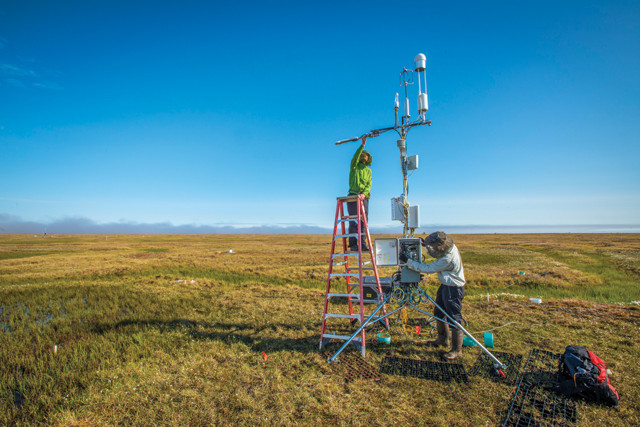
by Mary Caperton Morton Tuesday, March 14, 2017

Researchers check on a gas flux measurement tower in Alaska after the annual spring thaw. Credit: Stan Wullschleger.
During the few short months of Arctic summer, plants and animals race to grow and reproduce, fueling the most active time in the Arctic carbon cycle. But in a new study, researchers examining one corner of the Arctic demonstrate that ecosystems in the icy north aren’t entirely shut down during the offseason, with pulses of carbon dioxide and methane released some years starting during the first spring thaw.
“We often think of winter as a dead, deeply frozen time, when no biological activity is taking place,” says Naama Raz-Yaseef, an ecohydrologist at the Lawrence Berkeley National Laboratory in Berkeley, Calif., and lead author of the new study, published in Geophysical Research Letters. Due to that misconception — and the difficulties of working in the Arctic in the dark, frigid winter months — little is known about the Arctic’s winter carbon cycle. “We are seeking to better understand how feedback loops involving the carbon cycle and greenhouse gases are influencing climate change [in the Arctic], not just in the summer but year-round,” Raz-Yaseef says.
To better constrain pre-summer soil carbon fluxes, Raz-Yaseef and her colleagues, in 2012, built a 4-meter-tall gas flux measurement tower near Barrow, Alaska, as part of the U.S. Department of Energy’s (DOE) Next Generation Ecosystem Experiment project. In May 2014, the tower detected three releases of carbon dioxide and methane, the longest lasting five days, during the first thaw of the year. The carbon dioxide flux in those releases equated to 46 percent of the net carbon dioxide that is absorbed by Arctic carbon sinks in the summer months, while the methane emissions added 6 percent to known summer fluxes.
“At first we didn’t know if the fluxes were real or a measurement error, but when we compared the data to [measurements from] another flux tower [built in 2011 by DOE] located 4 kilometers away from ours, that location also recorded the same fluxes during the same time periods,” Raz-Yaseef says. Although the thaw occurred in May, conditions in Barrow at the time are not what are typically thought of as springlike, she says: “There’s no green yet, nothing growing. It’s still very early and very snowy.”
The team extracted cores of frozen soil from the study site and thawed them in the lab to determine where the carbon dioxide and methane pulses were originating. “We thawed them just as they would have thawed in the field: from the top down.” When the thawing hit a layer of organic-rich material, the researchers detected an emission of methane and carbon dioxide. The gases released had formed late the preceding fall, the team noted, when freezing of the soil from the top down and the bottom up created a sandwich of active microbial activity trapped in the soil. “For about a month, microbial activity is still taking place in this layer, producing carbon dioxide and methane, which is trapped by the surface ice. The gases remain trapped through the winter and then are released in the spring,” Raz-Yaseef says. The team also took CT scans of the soil cores, revealing networks of channels that could serve as storage pockets for the trapped gases.
This work is “part of a growing body of evidence [suggesting] that important events take place in the Arctic during the winter months,” says Ted Schuur, a polar ecologist at Northern Arizona University who was not involved in the new study.
Raz-Yaseef and her colleagues plan to have their towers in place in early May again this year to detect spring gas pulses, although they note that the emissions do not occur every year — pulses were not detected in 2013 or 2016 (and in 2015 the equipment malfunctioned). “The emissions seem more likely to occur when there are rain-on-snow events in early spring,” she says. “This triggers a freeze and thaw cycle that produces cracks in the frozen soil, through which the gases are emitted.”
How regionally variable such releases might be, and how they might affect the overall carbon balance in the Arctic, are unclear, Raz-Yaseef says. The Arctic is thought to be an overall carbon sink, storing more carbon than it emits on an annual basis. “Given our findings,” she says, “the Arctic may be a smaller carbon sink than previously thought, since the summer uptake of carbon by vegetation is [partially] offset by these spring emissions.”
© 2008-2021. All rights reserved. Any copying, redistribution or retransmission of any of the contents of this service without the expressed written permission of the American Geosciences Institute is expressly prohibited. Click here for all copyright requests.